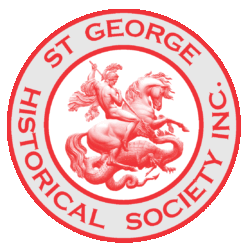This photo is one of a series taken from “The Towers” at Arncliffe in the early part of this century. Standing forlorn and neglected atop the Forest Road ridge, “The Towers” has sweeping views of the whole of Arncliffe. The series of photographs was taken sequentially in a 360 degree radius and present a clear …
Wazir Street, Arncliffe
by R. W. Rathbone (based on the research of E. C. B. McLeurin, former Head of the Department of Semitic Studies, Sydney University) Early in 1989, I was asked by the Council to compile a list of the streets in the Municipality of Rockdale and how they received their names. Many are named after the …
Smithson’s Wine Bar
by B.J. Madden Smithson’s Wine Bar in Stoney Creek Road was a feature of Kingsgrove’s life for about 50 years. (Smithson’s Tobacco Factory, run by Thomas Smithson, is a separate story). James Edward Smithson was a son of Thomas Smithson, and was born on 26 February 1844 at Leeds, Yorkshire. On 7 May 1867, he …
Reminiscences of Early Hurstville Families
by Thelma Hayman In 1911 when I went to live with my grandparents in Matthew Street, the lower end of which is now known as Hillcrest Avenue, this particular section of Hurstville was then being opened up as a residential area. It was not until the closing of the 1914-1918 World War that Hurstville Grove …
Continue reading “Reminiscences of Early Hurstville Families”
St. George 130 Years Ago
by A.H. Wennholm When the old Rockdale Town Hall was being erected in 1888-9, at the corner of Rocky Point Road (now known as Princes Highway) and Bryant Street, there was also being built a little stone church at the top of Bryant Street. The site selected for this church was a rocky one, consequently …

